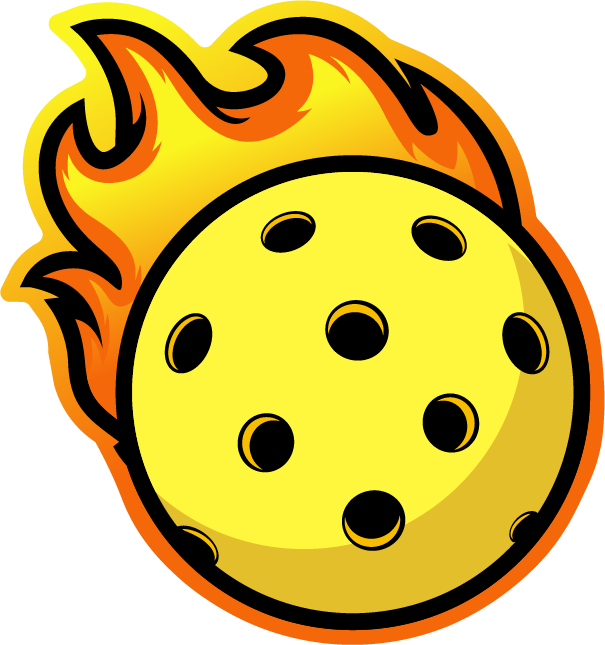One of the best things about pickleball wall drills is that they can be done almost anywhere. Whether you have access to a dedicated pickleball court or just a blank wall, you can start practicing your shots and improving your game.
Pickleball Wall Drills
Pickleball wall drills (or practicing shots against a wall) will help to improve your accuracy, speed, footwork, reaction time, and overall control of the ball. There are various types of wall drills that target different areas of your game, such as groundstrokes, volleys, and serves.
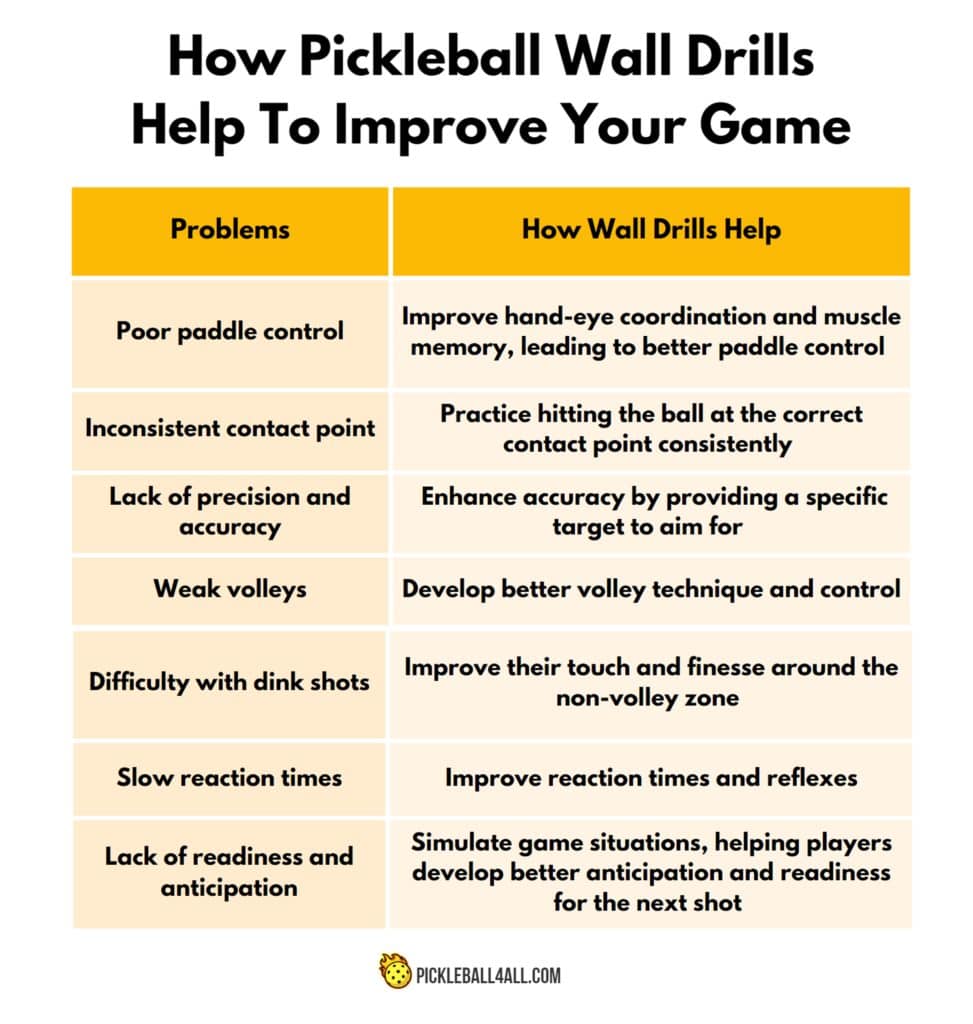
Setting Up for Pickleball Drills
You can set up your own practice wall at home or use a rebounder for convenience. Here are some tips on setting up your practice wall.
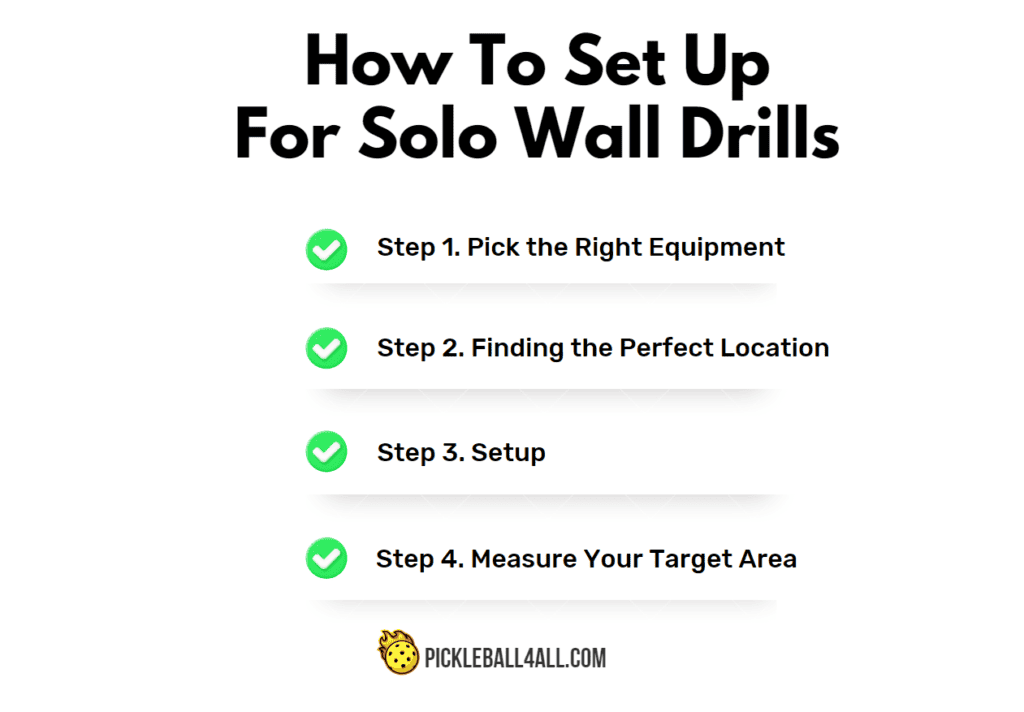
Step 1. Pick the Right Equipment
To practice wall drills, you will need the following items:
- Pickleball practice wall or rebounder
- Pickleballs
- Pickleball paddle
- Tape measure
- Tape, chalk, permanent marker, or wall drill target decals (optional)
Step 2. Finding the Perfect Location
When setting up your practice wall, you should find a wall at least 30 feet wide and 20 feet tall. The wall should be flat and free of obstructions.
It is better if nearby there is a location that provides enough space to move around and practice different shots. Ideally, you need an area of at least 20 feet by 20 feet. This will give you enough room to move around and practice different shots.
Practice can be made more convenient with the use of a pickleball rebounder. These days, you can find various types of rebounders like:
- The pickleball rebounder wall
- Pickleball rebounder net
- Training rebounders on a magnet for garage doors
- Wall drill target decals.
These options can help you save setup time and space for practicing. In this review, we have shared the best pickleball rebounder options.
Step 3. Setup
- Measure the distance between the wall and the baseline. This will help you determine where to place your target area.
- Make sure to use a horizontal line taped to the wall to represent the non-volley zone line. This will help you practice hitting shots above the net and improve your placement.
- If you are using a purchased practice wall, board, or panel, attach it to the wall using the provided hardware.
- If you use a rebounder, set it up according to the manufacturer’s instructions.
- If you plan to use the wall of your house or garage, it is crucial to properly prepare the surface. Start by cleaning the wall with soap and water to remove any dirt, debris, or dust. Once the wall is clean and dry, you can either draw the target area or apply a decal.
Step 4. Measure Your Target Area
Measure and mark your target area on the wall or rebounder using contrasting color tape, chalk, a permanent marker, or target decals. By the way, decals are easy to install and remove. The total target area for your practice wall or rebounder should be approximately 12 feet wide and 3 feet high.
How to Make a Pickleball Practice Wall?
Also, you can make your own DIY pickleball wall and move it to any place for training. Making a pickleball practice wall at home is relatively simple. Here’s a step-by-step guide to help you:
- Find a suitable wall. Look for a flat and sturdy wall that provides enough space for practicing your shots. It could be a wall in your backyard, garage, or even a local park.
- Clean the wall. Ensure the wall surface is clean and free of any dirt, debris, or obstacles. A smooth and clear surface will provide a better practice experience.
- Mark the target area. Use tape or chalk to mark the target area on the wall. You can create a horizontal line at the non-volley zone (kitchen line) height and mark a smaller target within that area for more focused drills.
- Set up the net line. If possible, mark the net line on the wall to simulate the net height. This will help you practice shots over the net and improve your shot selection and control.
- Add padding (optional). To minimize the impact on your paddle and reduce noise, consider adding a layer of foam or padding to the wall. This can be done using foam tiles or padding materials available at local hardware stores.
- Ensure safety. Make sure the practice area is safe and free from any hazards. Remove any sharp objects or obstructions that may cause injury.добавить видео это или другое
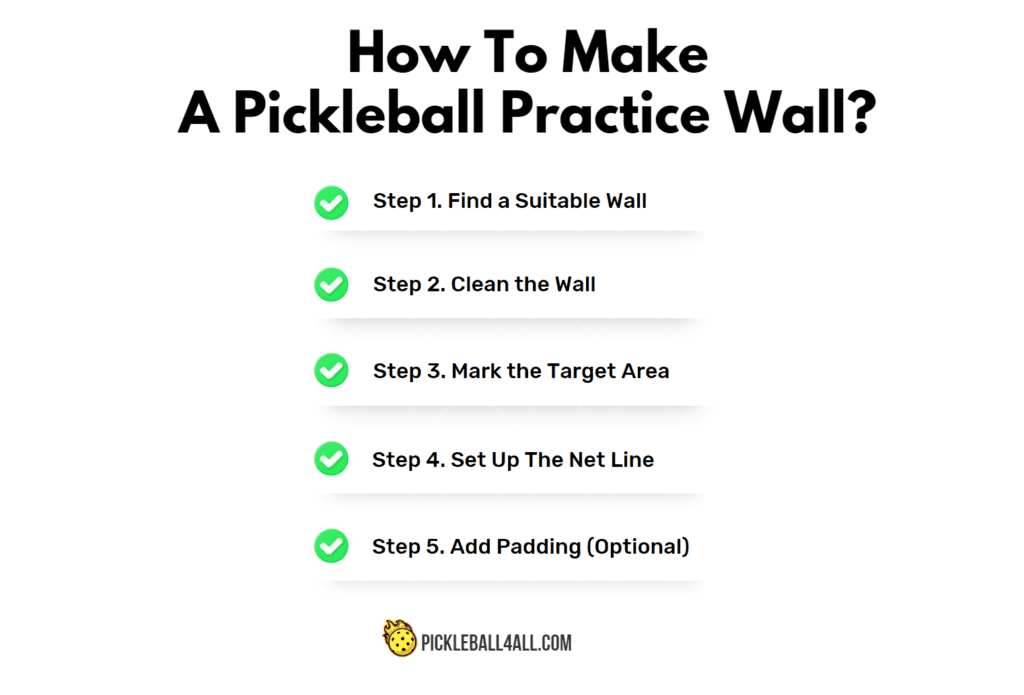
Top Pickleball Wall Drills
Wall drills help improve various aspects of your pickleball game. Such as forehand and backhand volleys, serving, shot placement, and reaction times. Let’s take a look at some of the top pickleball drills that can help you improve your game.
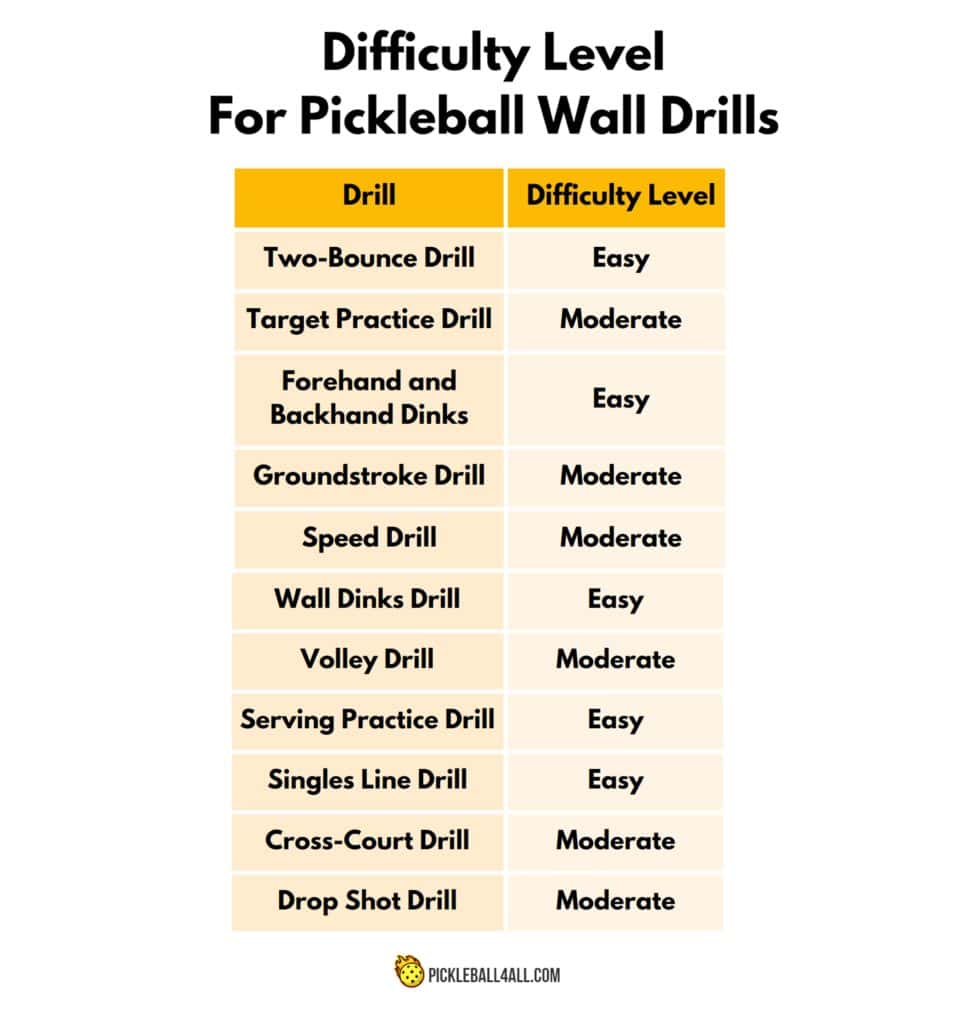
Two-bounce drill
Following drills involve hitting the ball against the wall, letting it bounce twice, and then hitting it again. You can start with a slow pace and gradually increase your speed as you get comfortable.
✔ Tip. Try to hit the ball to different areas of the wall to simulate real gameplay and practice your aim.
Target practice drill
Draw a horizontal line on the wall to represent the net and a small square on either side to represent the non-volley zone. The goal is to hit the ball into the square without letting it bounce twice. Start with a larger square and gradually decrease the size to make it more challenging.
✔ Tip. Focus on your contact point and follow through to improve your paddle control and accuracy.
Forehand and backhand dinks
This drill is specifically designed to improve your dink shots, which is an essential skill for any pickleball player. Stand at the pickleball court’s non volley zone line (the kitchen line) and practice hitting both backhand and forehand dinks against the wall. This drill will help you improve your control and touch on the ball.
✔ Tip. Aim for a high ball contact point to get more control over your dink shots.
Groundstroke Drill
The groundstroke drill is a fantastic way to improve your groundstrokes and consistency. Hit the ball against the wall, let it bounce once, and then hit it back. Alternate between backhand and forehand shots.
✔ Tip. Try to hit the ball at different heights to simulate real gameplay situations.
Speed drill
The speed drill can help you develop quick reflexes, and improve your reaction time and paddle speed. Hit the ball against the wall as hard as you can, and when it comes back to you, hit it again. Practice hitting the ball high and low, alternating forehand and backhand shots.
✔ Tip. Start with a slow pace and gradually increase your speed as you get comfortable.
Wall Dinks Drill
The wall dinks drill focuses on improving your dink shots. Stand in front of the wall and practice hitting forehand and backhand dinks. This drill enhances your hand-eye coordination, touch, and placement skills.
✔ Tip. Aim to land the ball softly near the net line, close to the non-volley zone, to replicate game situations and develop precise dink shots.
Volley Drill
The volley drills are designed to enhance your volley skills, both on the backhand and forehand sides. Stand near the non volley zone line (the kitchen line) and hit volleys against the wall, focusing on maintaining a steady rhythm and technique.
✔ Tip. Pay attention to your ready position and footwork, ensuring you are in an optimal position to react and hit volleys effectively. Practice with alternating forehand volley and backhand one.
Serving Practice Drill
The serving practice drill allows you to refine your serving technique and develop strategic placement. Position yourself at the baseline, facing the wall, and practice serving to specific target areas on the wall. Focus on hitting different serves, such as flat, topspin, and slice, to add variety to your game.
✔ Tip. Visualize the pickleball court and aim for target areas that will put your opponents in difficult positions or set up your next shot.
Singles Line Drill
The singles line drills help improve shot accuracy and consistency. Imagine the singles sideline and use it as a reference point while hitting against the wall. Practice hitting shots within the imaginary pickleball court, focusing on both forehand and backhand strokes.
✔ Tip. Use the imaginary sideline to guide your shot selection and develop a sense of court awareness.
Cross-Court Drill
For practicing the cross-court drills stand at one corner of the game area and hit shots diagonally to the opposite corner of the wall. This drill helps improve your cross-court shot technique and accuracy.
✔ Tip. Focus on generating good power and direction while maintaining consistency in your cross-court shots.
Drop Shot Drill
For practicing the drop shot drills stand closer to the wall and practice drop shots, aiming to land the ball softly near the net line. This drill enhances your touch, control, and ability to execute effective drop shots during a game.
✔ Tip. Work on varying the height and spin of your drop shots to keep your opponents off balance.
By incorporating these top drills into your training regimen, you can enhance your volley skills, shot accuracy, and overall gameplay. These drills improve your hand-eye coordination, muscle memory, and shot placement, allowing you to play the game at a higher level. Regular practice and repetition of these drills will help you become a more formidable pickleball player.
Pickleball Tips: Maximizing Your Practice Session
To maximize the benefits of your pickleball drills, consider the following tips:
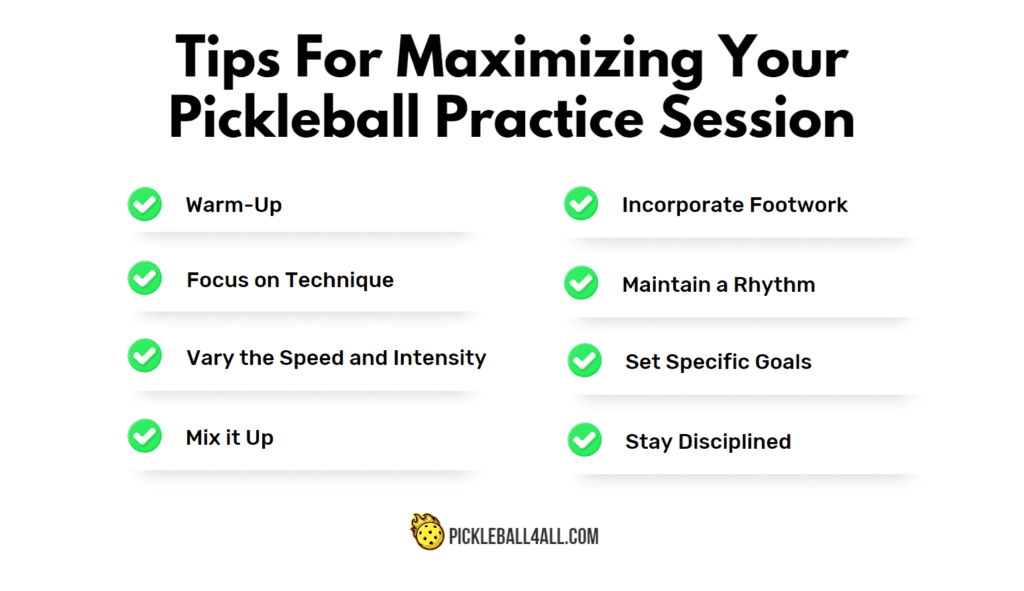
Final Thoughts
Wall drills can help you develop muscle memory, hand-eye coordination, and reaction times, which are all crucial skills in the pickleball game. Try to vary the speed, placement, and different types of your shots to keep your future opponent guessing. By practicing regularly, you can become a better pickleball player and win more games.
So, grab a ball and paddle and start practicing these drills today!
If you found this post helpful, don’t forget to share it with your fellow pickleball players on social media. Happy drilling!
FAQ
Can I use any wall or surface for pickleball wall drills?
Ideally, you should use a sturdy wall or surface that can withstand the impact of the pickleball. Suitable options include a solid concrete wall, a garage wall, or a specially designed pickleball rebounder. Ensure that the wall is large enough and offers a safe area to play.
Can I use a pre-made pickleball rebounder instead of a practice wall?
Absolutely! If you prefer a ready-made option, you can invest in a pickleball rebounder. These rebounders are specifically designed for pickleball practice and provide a more controlled and consistent ball return. They come in various types, such as wall-mounted rebounders or freestanding nets with rebound surfaces.
How do I set up pickleball wall drills?
To set up for pickleball drills, you’ll need a solid wall or rebounder, a pickleball, a paddle, and optionally, tape to mark target areas. Mark any target areas if desired, ensuring they are visible and securely taped. Ensure you have enough room to move and swing your paddle comfortably.
Can I practice pickleball wall drills indoors?
Yes, you can practice wall drills indoors as long as you have a suitable wall or surface. Garages, basements, or indoor sports facilities with appropriate walls are great options. Ensure you consider using softer indoor balls to minimize impact and noise.
How do I create target areas on the wall for pickleball wall drills?
If you want to create target areas on the wall, you can use chalk, or tape to mark them. Consider using different colors or shapes to represent specific targets. For example, you can tape a square for volleys, a circle for dinks, or a line for groundstrokes.
Can I perform do-it-yourself pickleball volley drills with a wall?
Absolutely! Wall drills are an excellent way to practice and improve your volleys. You can perform various volley drills, such as practicing forehand volleys, backhand volleys, alternating volleys, and volley exchanges.
How long should I practice each drill?
The duration of each drill depends on your personal preference and training goals. It’s recommended to spend at least 10-15 minutes on each drill to get sufficient practice and repetitions. However, feel free to adjust the duration based on your fitness level and available time.
What to use for dink shots while practicing alone?
One option is to use a plastic cup or a small target placed on the court to simulate the target area of a dink shot.
What are some basic pickleball drills I can do to improve my game?
There are a variety of drills you can use to boost your game. This includes wall drills, volley drills, and dink drills. Pickleball wall drills, for instance, involve hitting the ball against a wall to improve precision and control. Dink drills, on the other hand, help players master the soft, low shots that occur close to the net. And volley drills are all about quick reflexes and sharp hand-eye coordination.
What is a wall drill in pickleball and how is it done?
A wall drill in pickleball is a method where you hit the ball against a wall to get practice. The drill principally focuses on improving your hand-eye coordination, timing, and ball control. You need something solid that can return the ball to you. For example, a concrete wall. All you need is a wall, start by standing a few feet from the wall and then gradually increase your distance as your skills improve.
